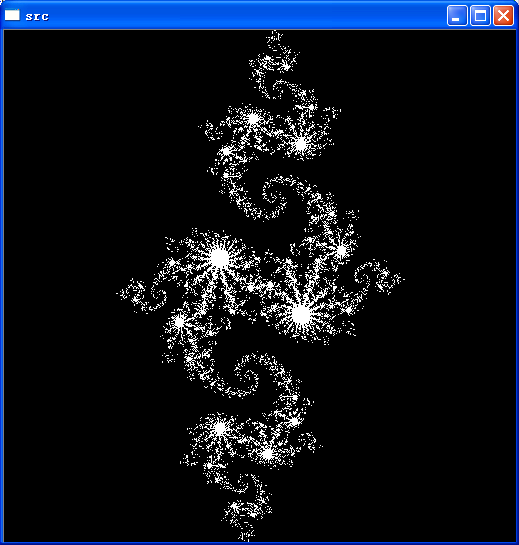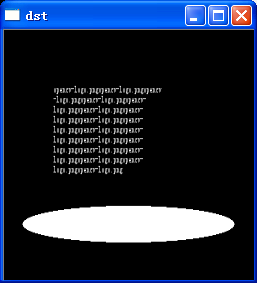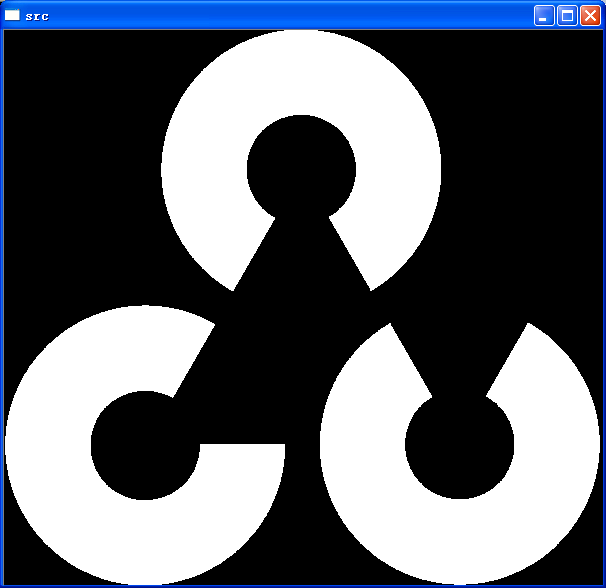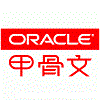CPU和GPU实现julia
# include <iostream >
# include "opencv2/core/core.hpp"
# include "opencv2/highgui/highgui.hpp"
# include "opencv2/imgproc/imgproc.hpp"
using namespace std;
using namespace cv;
# define DIM 512
struct cuComplex
{
float r;
float i;
cuComplex( float a, float b) :r(a),i(b){}
float magnitude2( void){ return r *r +i *i;}
cuComplex operator *( const cuComplex & a)
{
return cuComplex(r *a.r -i *a.i,i *a.r +r *a.i);
}
cuComplex operator +( const cuComplex & a)
{
return cuComplex(r +a.r,i +a.i);
}
};
int julia( int x, int y)
{
const float scale = 1. 5;
float jx = scale *( float)(DIM / 2 - x) /(DIM / 2);
float jy = scale *( float)(DIM / 2 - y) /(DIM / 2);
cuComplex c( - 0. 8, 0. 156);
cuComplex a(jx,jy);
for ( int i = 0;i < 200;i ++)
{
a =a *a +c;
if (a.magnitude2() > 1000)
{
return 0;
}
}
return 1;
}
int _tmain( int argc, _TCHAR * argv[])
{
Mat src = Mat(DIM,DIM,CV_8UC3); //创建画布
for ( int x = 0;x <src.rows;x ++)
{
for ( int y = 0;y <src.cols;y ++)
{
for ( int c = 0;c < 3;c ++)
{
src.at <Vec3b >(x,y)[c] =julia(x,y) * 255;
}
}
}
imshow( "src",src);
waitKey();
return 0;
}



# include "stdafx.h"
# include <iostream >
# include "opencv2/core/core.hpp"
# include "opencv2/highgui/highgui.hpp"
# include "opencv2/imgproc/imgproc.hpp"
# include <stdio.h >
# include <assert.h >
# include <cuda_runtime.h >
# include <helper_functions.h >
# include <helper_cuda.h >
using namespace std;
using namespace cv;
# define N 250
//test1的kernel
__global__ void test1kernel( int *t)
{
int x = blockIdx.x;
int y = blockIdx.y;
int offset = x +y *gridDim.x;
t[offset] = 255 -t[offset];
}
int main( void)
{
//step0.数据和内存初始化
Mat src = imread( "opencv-logo.png", 0);
resize(src,src,Size(N,N));
int *dev_t;
int t[N *N];
Mat dst = Mat(N,N,CV_8UC3);
for ( int i = 0;i <N *N;i ++)
{
t[i] =( int)src.at < char >(i /N,i %N);
}
checkCudaErrors(cudaMalloc(( void * *) &dev_t, sizeof( int) *N *N));
//step1.由cpu向gpu中导入数据
checkCudaErrors(cudaMemcpy(dev_t, t, sizeof( int) *N *N, cudaMemcpyHostToDevice));
//step2.gpu运算
dim3 grid(N,N);
test1kernel << <grid, 1 >> >(dev_t);
//step3.由gpu向cpu中传输数据
checkCudaErrors(cudaMemcpy(t, dev_t, sizeof( int) *N *N, cudaMemcpyDeviceToHost));
//step4.显示结果
for ( int i = 0;i <N;i ++)
{
for ( int j = 0;j <N;j ++)
{
int offset = i *N +j;
for ( int c = 0;c < 3;c ++)
{
dst.at <Vec3b >(i,j)[c] =t[offset];
}
}
}
//step5,释放资源
checkCudaErrors(cudaFree(dev_t));
imshow( "dst",dst);
waitKey();
return 0;
}



# include "stdafx.h"
# include <iostream >
# include "opencv2/core/core.hpp"
# include "opencv2/highgui/highgui.hpp"
# include "opencv2/imgproc/imgproc.hpp"
# include <stdio.h >
# include <assert.h >
# include <cuda_runtime.h >
# include <helper_functions.h >
# include <helper_cuda.h >
using namespace std;
using namespace cv;
# define N 250
struct cuComplex
{
float r;
float i;
__device__ cuComplex( float a, float b) : r(a),i(b){}
__device__ float magnitude2( void)
{
return r *r +i *i;
}
__device__ cuComplex operator *( const cuComplex & a)
{
return cuComplex(r *a.r - i *a.i,i *a.r + r *a.i);
}
__device__ cuComplex operator +( const cuComplex & a)
{
return cuComplex(r +a.r,i +a.i);
}
};
__device__ int julia( int x, int y)
{
const float scale = 1. 5;
float jx = scale *( float)(N / 2 - x) /(N / 2);
float jy = scale *( float)(N / 2 - y) /(N / 2);
cuComplex c( - 0. 8, 0. 156);
cuComplex a(jx,jy);
for ( int i = 0;i < 200;i ++)
{
a =a *a +c;
if (a.magnitude2() > 1000)
{
return 0;
}
}
return 1;
}
__device__ int fblx( int offset)
{
if (offset == 0 || offset == 1)
{
return offset;
}
else
{
return(fblx(offset - 1) +fblx(offset - 2));
}
}
//test3的kernel
__global__ void juliakernel( int *t)
{
int x = blockIdx.x;
int y = blockIdx.y;
int offset = x +y *gridDim.x;
int juliaValue = julia(x,y);
t[offset] =juliaValue * 255;
}
int main( void)
{
//step0.数据和内存初始化
int *dev_t;
int t[N *N];
Mat dst = Mat(N,N,CV_8UC3);
for ( int i = 0;i <N *N;i ++)
{
t[i] = 0;
}
checkCudaErrors(cudaMalloc(( void * *) &dev_t, sizeof( int) *N *N));
//step1.由cpu向gpu中导入数据
checkCudaErrors(cudaMemcpy(dev_t, t, sizeof( int) *N *N, cudaMemcpyHostToDevice));
//step2.gpu运算
dim3 grid(N,N);
juliakernel << <grid, 1 >> >(dev_t);
//step3.由gpu向cpu中传输数据
checkCudaErrors(cudaMemcpy(t, dev_t, sizeof( int) *N *N, cudaMemcpyDeviceToHost));
//step4.显示结果
for ( int i = 0;i <N;i ++)
{
for ( int j = 0;j <N;j ++)
{
int offset = i *N +j;
printf( "%d is %d",offset,t[offset]);
for ( int c = 0;c < 3;c ++)
{
dst.at <Vec3b >(i,j)[c] =t[offset];
}
}
}
//step5,释放资源
checkCudaErrors(cudaFree(dev_t));
imshow( "dst",dst);
waitKey();
return 0;
}






